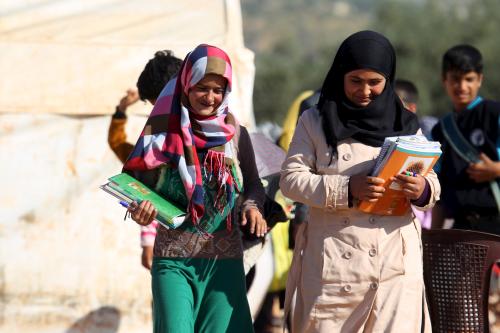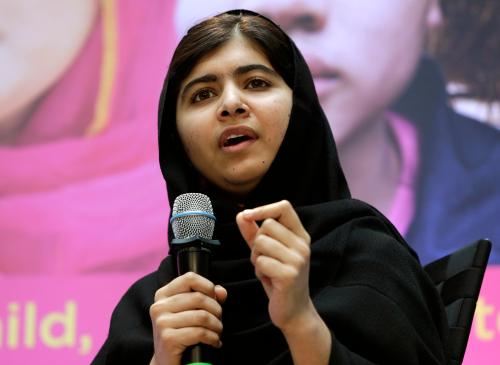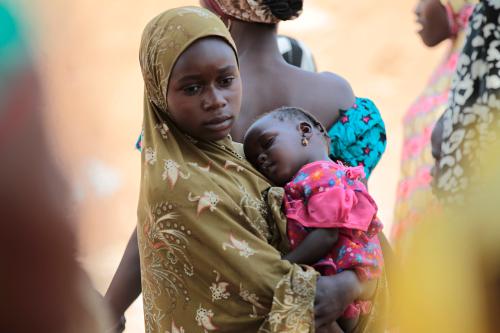Last week, as Malala Yousafzai, the Pakistani activist for female education and the youngest-ever Nobel Prize laureate, accepted honorary citizenship in front of the Canadian Parliament, her message was clear: girls from all over the world hold the key to today’s most pressing global challenges and climate change is chief among them. At the Center for Universal Education at Brookings, we couldn’t agree more and think her point deserves further emphasis and elaboration. Progress in girls’ education and climate change are intricately interdependent: girls’ access to schooling is disproportionately impacted by climate stress on households and communities, and girls, if afforded an education, are uniquely positioned to be part of key mitigation and adaptation solutions.
When facing drought, for instance, families must choose between sending their daughters to school and saving school fees to alleviate increased financial burdens. In Botswana, for example, girls made up 70 percent of children taken out of school during times of drought. Evidence elsewhere suggests that families even resort to marrying their daughters off earlier as a coping response to the economic hardships of climate stress, ultimately putting an end to her schooling and starting the expectations for her to bear children. And because women and girls are responsible for fetching water, droughts can cause them to spend up to four more hours per day traveling further to find it. Not only does that lead them to miss school at higher rates, but greater distance often also means greater risk of sexual violence, assault, or trading sex with older men for money or food.
Perhaps what’s worse is that women and girls tend to lack the knowledge and skills needed to survive natural disasters. They accounted for 90 percent of deaths resulting from the 1991 cyclone in Bangladesh, and 80 percent of those resulting from the 2004 Indian Ocean tsunami. And while we don’t know the full story behind this grim picture, we know that such deaths can be attributed to the lack of knowledge about signs of an oncoming tsunami, for example, or to the lack of simple life-saving skills like swimming. When women and girls do survive such disasters, they are disproportionately displaced and report being raped by men who rescued them from the water, or raped and assaulted in relief shelters.
Given such negative effects of climate change on girls and their access to school, it’s clear that we should amplify Malala’s point about girls’ education being the key to solving complex problems like climate change.
Experts at Brookings and the Center for Global Development have argued that the most cost-effective strategy to mitigating climate change is ensuring that all girls get a secondary education. The argument is simple: We know from girls’ education research that women with higher levels of education have fewer children. We also know that having one less person on the planet in the United States, for instance, can achieve 20 times the impact on reducing carbon emissions than slowing our global footprint through changing behaviors and lifestyles or pursuing renewable energies. So, if all girls and boys in the world were to receive a secondary education, there would be 2 billion less people and their carbon emissions on the planet by 2045 than current population projections predict.
Yet, moving beyond arguments that reduce girls’ and women’s role in mitigating climate change to her fertility, we must also remember that girls and women can contribute in far greater ways.
Yet, moving beyond arguments that reduce girls’ and women’s role in mitigating climate change to her fertility, we must also remember that girls and women can contribute in far greater ways. Key to Malala’s argument is understanding that a quality education for girls—one that creates opportunities for them to build knowledge and skills and to develop agency and choice—is what can ultimately lead girls to make better decisions for themselves that have positive and empowering intergenerational effects on their families, community, and country.
For example, we’re following a case in the Deh’Subz District on the outskirts of Kabul Province, Afghanistan, where a decision nine years ago to start the district’s only girls’ school has observed increased resilience and girl-friendly coping responses to drought among agriculture-dependent households that chose to send their daughters to the school. In these households, having an educated daughter has often meant the difference between families suffering financially due to reduced crop yields or crop loss and being able to pursue alternative non-agriculture-related income generating opportunities that are empowering for women.
And on the point of women’s economic empowerment, as the world shifts to a “green economy,” we must not forget to consider how, globally, girls and women tend to leak out of the Science, Technology, Engineering, and Mathematics pipeline over the course of their training. The millions of women and girls who are subsequently excluded from opportunities to drive the innovations and best practices of what is supposed to be a more socially equitable and inclusive economy means we are nowhere close to reaching our potential to generate diverse and inclusive solutions to humanity’s most pressing sustainable development challenge: the health of our planet. As Malala said, education is vital to the peace, prosperity, and security of our world, and we cannot achieve this vision while half of our population is left behind.







Commentary
Acting on Malala’s message: Girls’ education can lead to a healthier planet
April 21, 2017